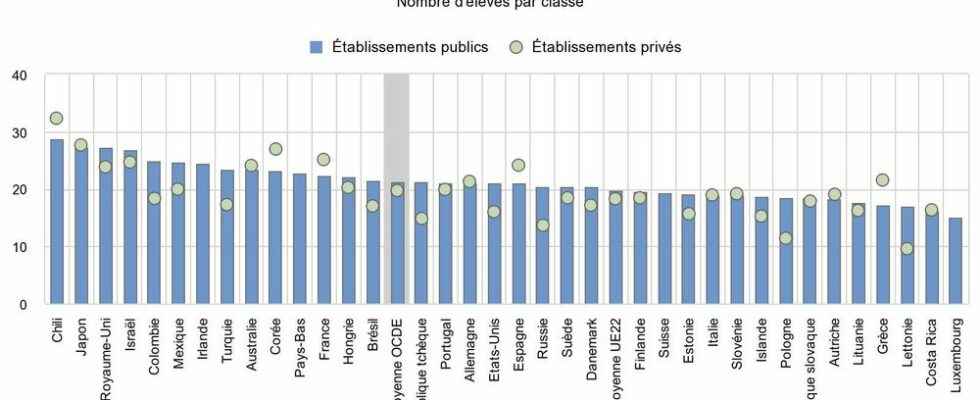This Thursday, September 1, when the roll call is called for the first time this year, primary school teachers will have 67,000 fewer names to pronounce than last year. In the midst of a recruitment crisis, the world of education could have been delighted. But if they hoped for tighter classes and a less busy schedule, the teachers will be disappointed… “With the lack of staff, we expect class closures, even more this year than usual. With an impact on the workforce”, regrets Guislaine David, co-secretary general of the SNUipp-FSU (union of primary school teachers). However, from 2020, the government has set itself the objective of capping the number of students in large section classes, CP and CE1 at 24. During Emmanuel Macron’s first five-year term, priority was given to primary school and the mastery of fundamental knowledge (reading, writing, mathematics). This measure was then supposed to come into force before the end of the mandate: this will not be the case, to the great displeasure of the teachers. “We end up with kindergarten classes around 29-30 and others, in CE2, CM1 and CM2 or even double-level classes, which are at 28-29”, notes the trade unionist.
Same problem in establishments of the priority education network (REP), for which the government undertook, in 2017, a policy of splitting classes, with a limit on the number of students to 12, first in CP and in CE1, then in the large kindergarten section from 2020. Two years later, this rule is still struggling to be fully respected. “Today, 75% of classes [en grande section de maternelle] are”, stressed the Minister of National Education, Pap Ndiaye, in his back-to-school conference on August 26. And to add that they will all be “at the start of the school year in September 2024”.
Still, France remains an average student compared to other OECD countries. With an average of 22.3 children per primary class, compared to 21.1 for the OECD average and 19.7 for the countries of the European Union, according to a 2021 Organization report.
With an average of 22.3 pupils per class in primary education, France is below that of the OECD (21.1).
OECD/UIS/Eurostat
“I spend more time disciplining than teaching”
What about colleges and high schools? “That there are announcements to reduce the numbers in the first degree is very good, but we must not forget the second degree”, insists Sophie Vénétitay, secretary general of the SNES-FSU (national union for the teaching of second degree). “Pap Ndiaye will not be able to be content with being the minister of fine speeches, we are waiting for action”, continues the professor of economic and social sciences (SES) in Essonne. Although middle school students are more “mature”, even more “autonomous”, teachers deplore “too heavy” numbers: “In high school we have classes of 36-37 students today; in middle school, they are 28-30 It has become the norm,” laments the trade unionist. “We have always denounced the fact that the ministry has never considered the question of enrollment in secondary education as a priority issue when everyone knows that we do not work in the same way with a class of 35 students, and one of 24.”
READ ALSO >> Maths: how to raise the level (while there is still time)
Sarah, a mathematics teacher recently arrived in Hauts-de-Seine (92), where she will manage 23 students in a REP+ college, says she is relieved by this number. In her old college, in the Toulouse suburbs, she had 28 dependent children. “It changes everything: when there are many of them, I spend more time disciplining than teaching, confides the young woman. I don’t have time to help students in difficulty and I have to spend to something else, while knowing that some did not understand. She is totally in favor of capping numbers, as in primary education, “but that means more classes, so more premises, money and teachers… so it won’t happen”, mocks- she.
Teacher shortage
It must be said that the profession is experiencing an unprecedented crisis of attractiveness, with 4,000 unfilled positions this year in teacher competitions in the country, out of 27,300 open positions in the public and private sectors. “There is a shortage of 1% of teachers in primary education, 8% in secondary education. […] This is not an optimal situation, I grant you that”, has already acknowledged the Minister of National Education. According to the SNES-FSU, 7,900 jobs have been cut since the start of Emmanuel Macron’s first five-year term. , both teachers and parents of students agree on one point: the only remedy for the drop in numbers per class is the recruitment of teachers. Nevertheless, “there is a problem of salary, recognition and progression in their work”, recognizes Patrick Salaün, president of the Unaape (National Union of Autonomous Associations of Parents of Students).
As a result, National Education relies on contract workers, recruitment and express training. These represent about 8% of secondary school teachers, according to the ministry. The latter assures him: “80 to 90% of contract teachers already have teaching experience.” Pap Ndiaye has also announced that a competition for the tenure of certain contract teachers will be exceptionally organized in the spring of 2023. After the health crisis and the delay taken by certain pupils, the measure leaves parents of pupils skeptical for the moment.
